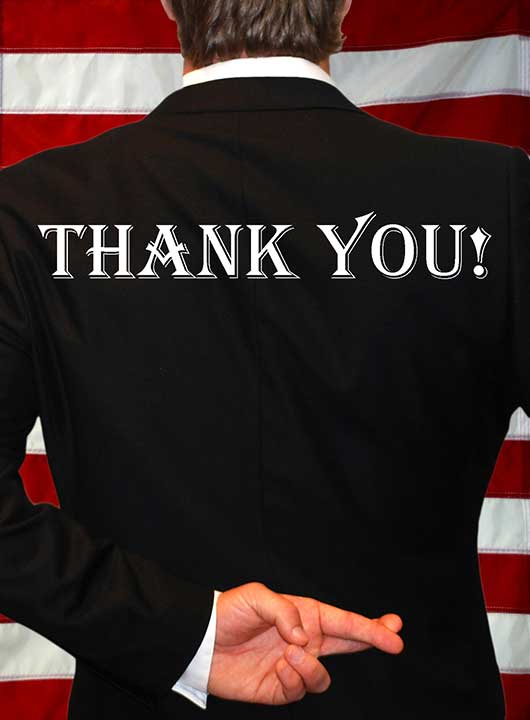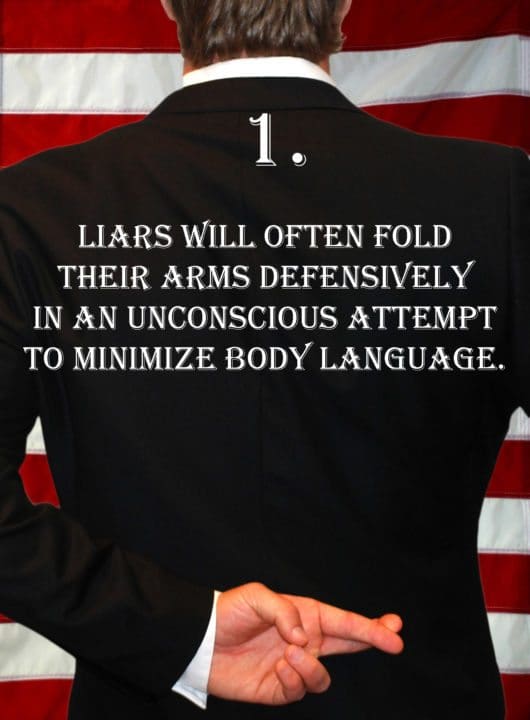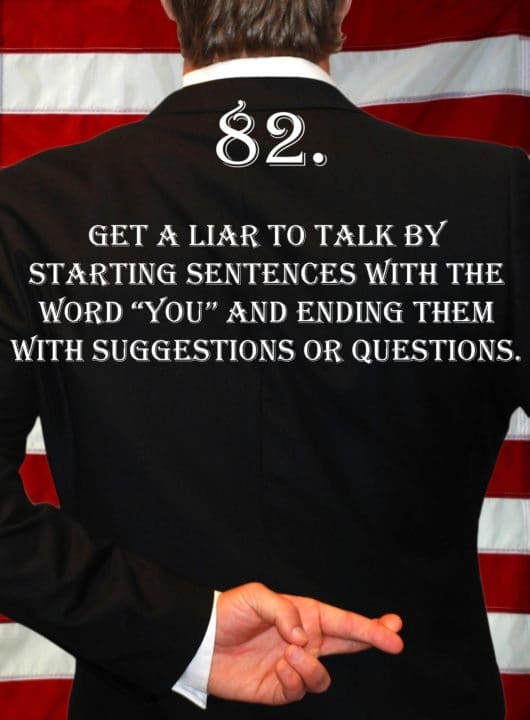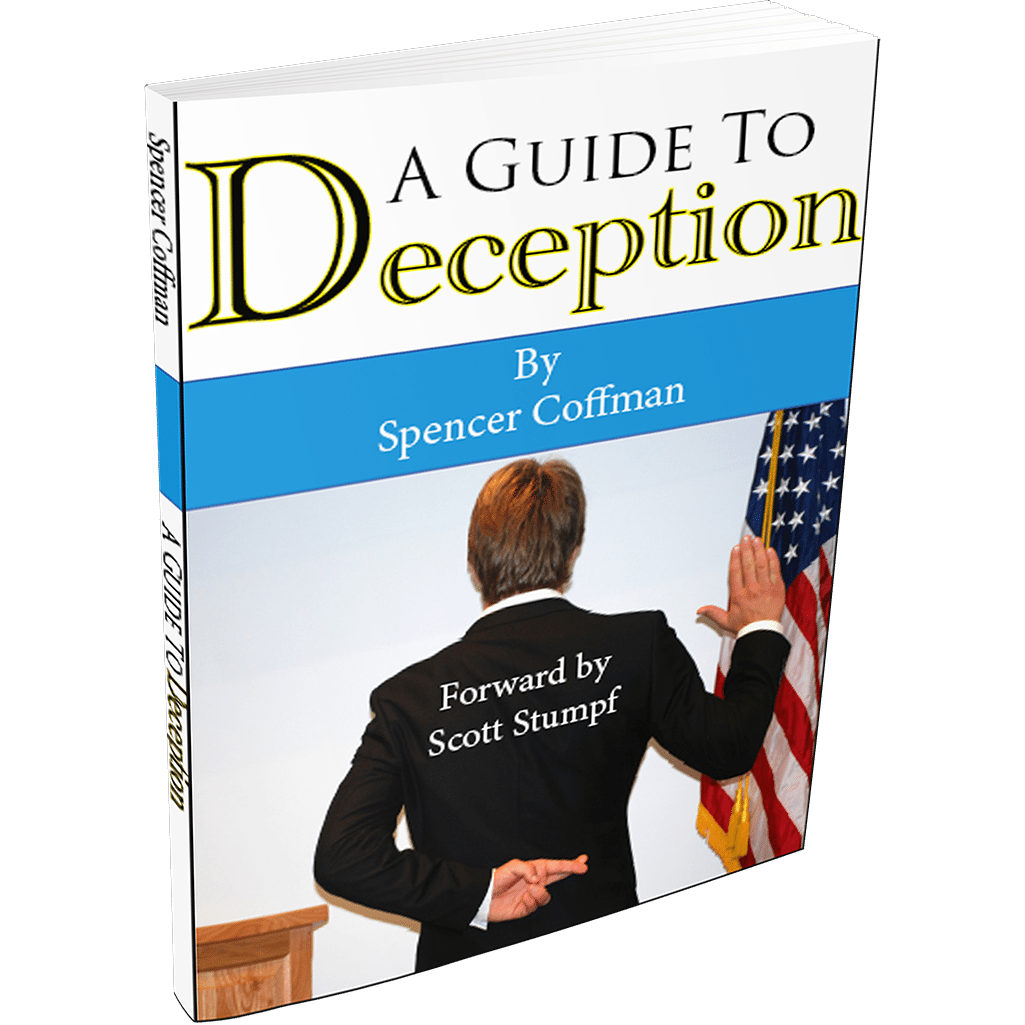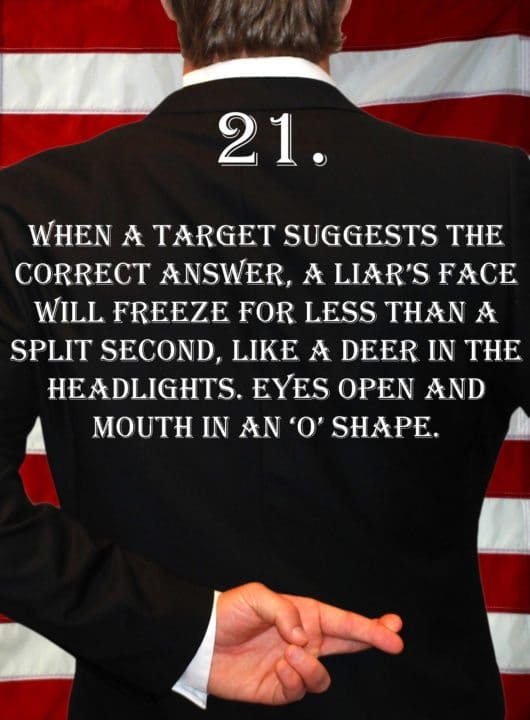
Deception Tip 21:
When a target suggests the correct answer, a liar’s face will freeze for less than a split second, like a deer in the headlights. Eyes open and mouth in an ‘O’ shape.
Listen To The Podcast!
E21 – Suggesting Answers – Deception Tips Podcast – Click Here To Subscribe
Podcast Transcript
Hello, and welcome to the Deception Tips Podcast, where you will learn amazing cues to detect deceit that will help you read people like never before. I’m your host, Spencer Coffman. Let’s get started.
Welcome to episode 21 of the Deception Tips Podcast. Thanks for tuning in. Last time, we spoke about a great sign of deception that you can see. And, it was a huge myth that many people believe is incorrect.
So, when you’re watching people and detecting deception, watch out for increased eye contact. Liars often display increased eye contact so that they can watch the target believe the lie.
This is completely contradictory to popular belief that says that when people look people in the eye they’re telling the truth. You know the statement, “Look me in the eye so I know you’re telling the truth.” You may have even used it on your kids or someone else.
Or, you maybe have been said it to yourself. Someone may have said that to you and you had to look someone in the eye and tell them whatever. But, the point is that liars often do this because they want to watch the target believe the lie. That is their goal.
A liar’s purpose- their number one purpose- is to convince other people of their lie. Number two: they need to convince themselves of the lie so they can believe it. But, their goal is to be believed.
That’s why they’re telling the lie in the first place. So, if they have the opportunity to watch the target believe the lie, they are going to take it. And, that’s why they often display increased eye contact, to begin with.
However, if the target gives them permission to continue looking into their eyes, then they are golden because now they know that the target isn’t going to see anything else on their body. Or, at least very much less likely to see something on their body.
They are going to have them concentrate completely on their eyes where there are very minimal signs of deception. This is 21, and as I mentioned last time, we’ve really only talked about one solid sign on the eye. Whereas most of these other signs are on the body and in other areas. So, pay attention to the entire field of vision.
I also gave you a little bit of a challenge last week to look someone in the eye for a period of five seconds- someone you weren’t in love with or are not in love with. It has to be someone else.
Hopefully, you tried that out and you will see that it is kind of a period of discomfort. It’s something that is unnatural. We normally don’t hold direct eye contact for more than 30–40 seconds. Usually, gazing that deeply into someone’s eyes is not common behavior.
Most of the time, when people are speaking with one another, they work the entire field of vision. They look at their body, and their clothing. They watch their hands move, their gestures. They look around behind them, at other people. To the left, to the right.
They may look at their own hands or their watch. Things like that. People tend to look around the whole field of vision. They don’t only look straight into someone’s eyes. Doing so is uncomfortable and unnatural. Therefore, when a liar does it, that is a huge sign of deception because it’s not normal. So, pay attention to increased eye contact.
Today, we are going to talk about a form of deception that is more of a strategy that you can use to watch and determine whether or not someone is lying or telling the truth. We’re going to talk about the consequences of behavior and suggestions and get their opinion.
And, the reason this is so effective is that when you incorporate their input into the outcome, or into the stories, or into something else, they are going to slip up because now they think that they might be beating you.
They feel like you are listening to them. They feel like you might be believing them. This goes on with another story, or another time, that we talked about different strategies where you may suggest different stories to people with rehearsed stories, or give them things.
I talked about the Texas example where I was talking with a kid and then I mentioned, “Oh. I’ve never been to Texas. Have you?” And he said, “No!” and, that was how I caught them in a lie. Different things like that where you can bring up things and get them to kind of believe that you may be believing their story. Or, bring in things from their story. “So, when you said you did x, y, z, then what happened?”
Now they know that you’re listening to them and they know that you may be on the track to believing them, so they’re going to continue talking. And, chances are, they’ll trip over their tongue and they’ll slip up.
So, today we’re going to talk more about those types of things. Things that you can do to enhance their story, and dig a little bit deeper, prod, and give them more opportunities to continue talking so that there are more chances of them displaying more behavioral signs of leakage, verbal signs of leakage, etcetera.
So, today, here it is. Deception Tip 21: When a target suggests the correct answer, a liar’s face will freeze for less than a split second. Like a deer in the headlights- eyes open and mouth in an “o” shape. Here it is again. When a target suggests the correct answer, a liar’s face will freeze for less than a split second. Like a deer in the headlights- eyes open and mouth in an “o” shape.
So, there are a number of components to this tip. Number one is the target is suggesting a correct answer. So, this is something where it’s a strategy AND it’s a direct sign of deception. You can suggest things to the target. Now, this isn’t like suggesting scenarios or stories. This is more of guessing an answer.
This is like, “Okay. Where are the keys hidden?” So, they’re lying saying, “Oh yea. Well, I didn’t hide the keys.” Or, “I hid them here.” Or, “I did this.” And, you might be looking at them saying, “Alright. Did you hide them in the mailbox?” “Did you hide them in the drawer?” “Are they on the counter?” “Are they in (whatever)?” “Did you put them in the fridge?”
And, you suggest these different answers and watch their face. And now, their face- when you hit the right answer- you don’t know it’s the right answer, but they know where they hid the keys.
So, if let’s say the right answer is they put them in the mixing bowl on the counter and you may say, “Are they in the Kitchen Aid mixer?” Boom! Their face freezes because they’re caught in the lie. Like *gasp* and they freeze and now this is the next part they freeze for less than a split second.
Now, this is kind of confusing, and maybe a little bit redundant, but it’s done that way purposefully. Because, emotions, and micro-expressions, only happen in a fraction of a second.
Micro-expressions are like a quarter of a second or less. I mean it is VERY, very instant, split-second. So, this will happen for less than a split second. It is a very, very short period of time where they may take a sharp inhale, their mouth will freeze, and their mouth may open up a little bit in form of a surprise/fear blend emotion.
So, you’ll see the eyebrow go up, the lower part of the eyelid goes down a little bit, you’ll see the whites of the eyes on both sides of their pupil and iris there, and you’ll be able to see that. But it’s very, very brief.
In addition, their mouth, will kind of open in an ‘o’ shape. So, surprise is an expression where the jaw just kind of drops open and that is, like an oblong shape. This is more like an ‘o’ shape as in like surprise. Like someone’s like, “oh.” So, it’s more rounded.
Now, we’re going to talk a lot more about this, and a lot more about how this is displayed, and how you can elicit this, or solicit this, reaction and response when you’re questioning people coming up after this.
How would you like to really know what every body is saying? Understanding body language can help you in your career, your relationships, and everyday interactions. Get Spencer Coffman’s A Guide to Deception online today.
Suggesting answers is a very, very popular tactic when it comes to lie detection and deception detection. Interrogators use it all the time where they put people in chairs and they stand over them with a map and they’re trying to find the location of something.
They run their finger over things. They watch people’s reactions to hone in on certain areas. Or, they have lists of names and, as they read off the names, they watch them. Or, as they scroll their finger down the names they watch the person’s reaction. It’s in a lot of tv shows. It’s a very popular interrogation technique.
Now, in the tv and movies, they make it seem a lot easier than it really is. It’s not simply quickly running your finger down a long list of names and then all of the sudden stopping on the correct one when the guy held his breath. No. It’s more than that.
It’s a lot more than that and it usually takes a few times to find the right one. It’s the same with guessing the cards in a deck. I love this trick. It’s very great. If you can get good at reading people, it’s an awesome trick for parties, or gatherings, or things like that. I used to do it all the time. It’s really quite fun.
What you do is you take- you don’t even need a deck of cards, but it’s more fun with a deck of cards- and you tell the person, “Pick a card.” And, they don’t even need to pick a card. They just think of a card. Then go through- “Is it Red? Black? Red? Black?”
Pretty soon, you’ll be able to watch them. “Ok. High card is 8 and above. Low card is 7 and below. Ace is counted as a low card.” Go through. Ok, “Is it high or low? High or low?” and you can watch their expressions, their thought process, their body and see. Ok, what are they doing? When I say “high,” are they reacting or “low” are they reacting? And then you can choose. “Well, ok. It must be a high card.”
Alright so, let’s start at 8 and you just count right up! “8? 9? 10? Jack? Queen? King?” Then see how they go. “Ok. It might be this.” So, now you know. “Alright, it’s a black, high card and it was like a Jack/King/Queen area.” So, now go over. “Jack? Queen? King?”
Figure out which one it might be. If you’re still not sure. Alright, you know it’s black. “Is it a spade or is it a club? Spade or club? Spade or club?” Ok, it’s a club. Alright, Jack? Queen? King? “Ok. It’s the Jack.” Boom! “How did you do that?” You watched their reactions!
This is a very popular one because, oftentimes, when you guess the correct answer, they may freeze for a split second. They may pause. Their mouth may go open in an ‘o’ shape. “OH!” Most of the time when people get caught, or when people crash, or when things happen that are surprising and instant, their common reaction is “Oh …!” And, you can fill in the blank. It’s a four-letter word. It starts with an ‘S.’ But, that is the big reaction.
Anytime, if you’ve ever been in a car accident if you’ve ever gone in a ditch, what is the first thing that went through your mind? Likely, that’s what it was. It is very, very popular, in fact, in a lot of airline crashes and recordings, that is the last thing that the black box, or whatever, records before they’re about to crash, during simulators, etcetera. Any of that.
It’s a very popular phrase when people get caught or when people make a mistake and they know it. So, that’s about what it is. And, you can watch these people when you’re guessing these things and see that precursor right on their face. That surprise was right on their face.
So, it’s a great technique to use. Now, of course, there will be more signs. These signs will come after this. This is more of a micro-expression. It’s a split second. It’s something that happens in an instant. And, as I said, you may have to do it several times. “Red? Black? Red? Black?” Say it several times because, oftentimes, maybe the first time you miss it, or maybe they didn’t display it, or maybe they didn’t hear you. There could be a variety of reasons.
So, the more you do that- or if you have a list of names you’re trying to get. “Which name did you- which politician did you bribe?” And you have a list of names and you’re trying to get it from somebody.
Now, you’re probably not going to be trying to get that information from somebody, but maybe it’s “Which kid is the bully that’s beating you up at school? Is it Jack? Or is it Joe? Or is it this guy? Or this guy? Or this guy?” And, they may not want to tell you.
But, through that, you could do it- especially with the children because they’re more expressive. They haven’t learned how to control and hide those emotions as well as adults.
The longer we go through life, the better liars we become. Why? Because we practice a lot and we do it every single day. We may not do it maliciously every single day. But, you lie every single day. You probably lie at least ten times a day when you think about it. “How are you doing today?” “I’m good.” Well, your dog just died. You’re not good. Or, something like that.
You’re sick. Your kid is home from school. You missed work. Whatever the case- or, “How are things going?” “Things are good.” Well, you’re a hundred grand in debt from student loans. I wouldn’t call that good. Things like that. You lie all the time. “Did you like the food that grandma cooked?” “Yea. It was alright.” No. It sucked.
There are different things that people do and it’s- oftentimes, it’s polite, social lies that occur. But, pay attention to how many times you say something that may, or may not, be true. It could be an untruth or a half-truth.
That’s still a lie. Now, it may not be malicious or destructive, but it’s still a lie nonetheless. Now, do I recommend you go around and say the truth all the time to everybody? No, because then you’ll end up being like a jerk.
If someone says, “How do you like my new haircut?” “Aw, I think that’s the worst thing I’ve ever seen.” Boy, that’s not going to be very nice. But, if you say, “Well, it’s alright, but I liked your other haircut better.”
Now you’ve kind of told the truth but you didn’t insult them. That’s the big thing. If you just tell the straight truth all the time you’re going to be very insulting and very, very tough to be around. But, if you lie all the time, it would be the same thing. So, find that happy medium.
But, the point of this whole episode is you can watch things, and when you suggest different outcomes, and different scenarios, or different answers, watch people’s faces. Watch people freeze for a split second. This is a more advanced thing to spot, but with practice, you can see it.
Get a deck of cards. Try out that trick and practice. Practice. PRACTICE. Pretty soon you’ll be able to do it right away. You’ll be able to read people and know what card they had by simply guessing and getting them to show different signs of body language and deception. Because there will be more than one sign.
This sign will probably be one of the first that’ll come out on them because it is a quick micro-expression. Eventually, you’ll be able to see a lot more of these micro-expressions but just know, this will be one of the first. Then other signs will follow. So, if you miss it. Don’t worry. Watch for other signs. There will always be more than one sign.
I want to thank you for listening to this week’s episode of the Deception Tips Podcast. I encourage you to share it with your friends, subscribe to the feed, check out the Deception Tips Blog, and take a look at the books I have available. And, as always, tune in next week for a new Deception Tip.
Video Transcript
Hey guys, my name is Spencer Coffman. Thank you for watching the Deception Tips Videos. They are a hundred percent dedicated to teaching you how to detect deception so that you will be able to know if someone is lying to you.
Today, we are going to talk about a cool tactic that you can use to catch a liar and to not only catch a liar, but this is more when the liar is withholding information rather than telling or giving, or falsifying information. This is like when you are trying to seek the truth whether you’re trying to find out where someone hid something. Or maybe you could do it as a game, and you say, “okay, pick a number,” and you try to figure out what number they’re thinking of, or what car does thinking of, or where they’ve hidden your keys, whatever the case may be.
Or, if it’s something more serious like you’re a police officer when you’re trying to find where the drugs are hidden, or a bomb, or XYZ, it doesn’t matter. This is more when the lying of concealment, rather than lying of falsifying a story. So this is a great tactic that you can use, and it is about suggesting answers.
So here this is Deception Tip 21: When a target suggests the correct answer, a liar’s face will freeze for less than a split second, like a deer in the headlights. Eyes open and mouth in an ‘O’ shape.
Now, there is a lot to this tip, So I’m gonna break it down real easily. So the first thing is when the target is suggesting answers. Now, this doesn’t mean that they are suggesting parts of the story for the liar to incorporate and then determine whether or not they’re telling the truth, no. This is like when the target is more guessing or, coming up with possible answers to whatever they are trying to find.
So they may say, “you know, is it at, where is it? At what church? Is it at this one, or this one, or is it here, or there? Is your number that you’re thinking of, is it an even number, or an odd number?” And the liar is not answering these questions verbally. However, non-verbally, they will. And so if the liar is withholding this information, the target can start suggesting possible answers. What they think might be the truth, or what they think might be the correct answer, and the liar, their body will react to that, because they obviously know what’s wrong and what’s right.
And so, as the target is suggesting answers that are not correct, they may show contempt, or happiness, or something on their face. But when the target is suggesting a correct answer or gets closer to what the answer really is, then that liar may show fear, or contempt, or some type of a, they may be like surprised that the target actually got the right answer without the liar saying anything. In addition, they will freeze.
So this is important because typically when someone is guessing the answers and the liar will probably just kind of sit back, they may look cocky because they see that the target is barking up the wrong trail, they may show that kind of happiness, or enjoyment. Now it won’t be jumping up and down happy, but it’ll be on their face. Slight, quiet happiness.
Then as the target gets closer to the correct answer, or if it’s a list and the target is running their finger down the list, seeing which of the answers is correct or which of whatever is the one that they want, then the target will know by looking at the liar, and will see that the tension and the stress will become more and more. It’s like it’s boiling up inside of them, and as soon as that right answer hits, then they will like, burst. And they will be surprised, like a deer in the headlights.
They’ll freeze, and then in some cases, if the liar is really expressive, their mouth will drop open as in like a, it’s a prolonged or delayed surprise. Kind of like a. Like, you know, “you’re not, you’re a, what are you, a codfish?” type of a thing. Or, “close your mouth, you’re not catching flies,” because they’ll be surprised, they’ll be shocked. Now, typical surprise is really, really quick. It’s less than a second. It’s like, instant.
Whereas this type of surprise is more prolonged and delayed because they really can’t believe what is going on. They are, they’re like, they’re just in awe that they can’t figure out how that the target guessed the correct answer. But as always, there will be more than one sign.
So within this, you can look for the freezing, the deer-in-the-headlights, the mouth dropping open, but also pay attention to the precursor behaviors, such as enjoyment, or contempt, or happiness that might be going on within that liar as you’re going down the wrong path. And then watch for the aftermath. If you may have hit the correct answer and then get off of it, their behavior may change. So watch out for those patterns and those clusters of behavior as always.
If this is your first time watching these videos, I would love to have you subscribe to the channel on YouTube. Feel free to leave any comments or questions on them as well. In addition, if you’d like some more information, we’ve got books, podcasts, blog posts, all available on SpencerCoffman.com that are dedicated to showing you exactly what every body is saying.
Until next time.


